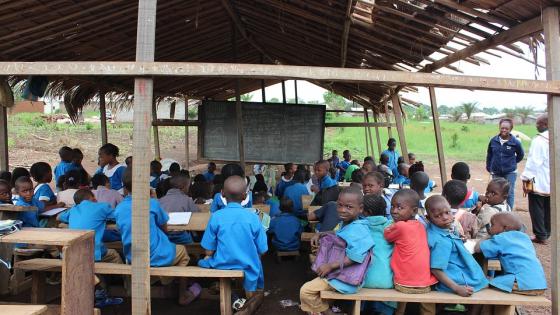The notion that public investment in infrastructure is an important driver of economic growth can be found in much of the political and economic discourse on poor economies. But, it has recently also gained momentum in the case of emerging markets and advanced economies alike as a result of the Great Recession. The World Economic Forum (2004) estimates global spending on infrastructure investment to amount to US$3.7 trillion per year, and yet a spending gap of at least US$1 trillion still exists every year. In his seminal paper, Rosenstein-Rodan (1943) argued that a “big push” of investment-led growth would enable economies to loosen multiple constraints, benefit from economies of scale, and generate the needed demand.
Choosing how to best allocate public infrastructure investment is of fundamental importance for policymakers across the globe. For simplicity, we can think of decomposing public investment into ‘roads’ and ‘schools’. While the former stands for economic infrastructure, i.e. the capital inputs that allow the economy to function better (such as roads, railways, ports, water, power, and telecommunications), the latter stands for social infrastructure, i.e. the capital that primarily delivers social services (such as schools, universities, and hospitals). While governments continuously face the problem of maximising the supply of a wide variety of public goods subject to constrained budgets, focusing on schools is particularly relevant for developing economies—emerging markets and low-income developing countries (LIDCs) alike.
The case for investing in schools
Although public investment in roads represents an important engine of growth for many developing countries, investing in schools would appear to be an even more pressing need for them. Acosta-Ormaechea and Morozumi (2017), using disaggregated public spending data for 83 countries with different levels of income, show that spending reallocations from roads to schools has growth-promoting effects. More importantly, these effects are significant only when a country’s income level is low. Using a panel of 30 developing countries, Bose et al. (2007) show that an increase in spending on schools, financed by non-tax revenue, results in higher growth, whereas an increase in spending on roads does not.
Suggestive evidence shows that developing economies (with lower GDP per capita) spend less on schools than on roads, both in absolute terms and as a fraction of GDP. This can be inferred from Figure 1, which shows data on social spending (i.e. the sum of public spending on education and health) and public investment (i.e. infrastructure-related spending) for a cross-section of countries for the 2000-2008 period.
Figure 1 Public investment and social spending along the development path
Sources: World Bank’s World Development Indicators and IMF’s Fiscal Affairs Department.
Recent theoretical contributions have focused particularly on the nexus between government infrastructure spending and its effects on growth and public debt sustainability (e.g. Buffie et al. 2012). However, most analyses look at one broad measure of public investment, abstracting from its composition. Those that do take the composition into account assume a budget-neutral fiscal policy, hence ruling out important fiscal policy considerations.
Why do developing countries not invest more in schools?
In light of the empirical evidence, in a recent paper we study the macroeconomic and (public) debt sustainability implications of investment in roads versus schools in the context of an infrastructure scale-up programme (Atolia et al. 2017). We show not only that the composition of public investment has important macro-fiscal implications, but also that these, in turn, affect the welfare-optimal investment composition. We explore and address the following questions:
(1) Why is public spending on social infrastructure not higher in developing economies?
(2) What determines the composition of public infrastructure investment?
We study these issues in a relatively standard economic model, but with a realistic and detailed specification of fiscal policy, which includes distortionary losses from taxation and government’s aversion to incurring debt. The model also features accumulation of human capital, which is accrued via an optimal decision of households of postponing labour supply (and leisure) in order to spend time in schools, while the capital cost of building schools and all current expenditures to maintain them are borne by the government. In the presence of these features, the difference in the pace with which roads and schools contribute to economic growth turns out to be of central importance to the policymaker’s optimal allocation decision. Upgrading economic infrastructure increases the productivity of private firms relatively quickly, whereas the scale-up of schools raises workers’ productivity mostly in the long run—albeit potentially to a larger extent—while requiring similarly large upfront costs. Additionally, social infrastructure entails larger current expenditures, including those for operations and maintenance.
Calibrating the model to an average developing economy and accounting for the relative scarcity and higher return of human capital (as in Acosta-Ormaechea and Morozumi 2017; see also Bose et al. 2007), a permanent public investment scale-up exclusively in schools results in a much larger long-run increase in output than in an opposite scenario in which the new public investment occurs exclusively in roads. Yet, for a prolonged time (around 15 years) the economy enjoys faster growth by investing only in roads, and it takes about a generation (almost 24 years) for the output obtained by investing in schools to overtake that delivered by investing in roads. This has tremendous fiscal implications, with schools causing a threefold peak increase in government debt relative to roads.
Under a ‘big push’, public investment becomes more front-loaded and may tilt the balance in favour of investment in schools in two ways. On the one hand, it shrinks the delay with which output resulting from investing in schools overtakes that from investing in roads and results in very similar paths of public debt. On the other hand, while accelerating the transition to a higher output in the long run, on the downside it may lead to a stronger medium-run drop in output and private consumption, amplifying the intertemporal labour substitution effect associated with a scale-up in schools.
These trade-offs have clear welfare implications. First, even with a large (15%) return differential in favour of schools, the government optimally chooses to limit the fraction of the investment increase dedicated to schools to about three fourths, which falls to about a half in a typical ‘big push’. Second, these shares drop even further if the government is debt-averse or access to debt financing is simply not feasible. Third, if political leaders have a planning horizon of less than 30 years—call it ‘myopia’—they would not invest in schools at all. A time horizon approximately twice as large is needed for investment in schools to be of a comparable magnitude to the case of a benevolent social planner.
Conclusions
Overall, proper consideration of macroeconomic and fiscal concerns can explain why many governments may be reluctant to spend as much on schools. The different pace with which roads and schools contribute to economic growth is central to this optimal allocation decision. The combined dynamics of front-loaded fiscal costs of investments and slow pace of accrual of growth benefits from investing in schools—albeit larger in the long run—does not square well with a macro-fiscal regime with distortionary taxation and debt intolerance, with political myopia adding further fuel to the fire. Multilateral agencies could alleviate these concerns and incentivise policymakers in developing countries to undertake long-term investments in schools by providing tied concessional financing and grants. While tying aid to investment in schools would also address the issue of political myopia, concessional terms would mitigate concerns of debt intolerance.
Authors’ note: We acknowledge also the financial support from U.K.’s Department for International Development (DFID) under the project “Macroeconomic Research in Low-Income Countries,” with project ID number 60925. The views expressed here are those of the author(s) and do not necessarily represent the views of the IMF, its Executive Board, or IMF management. All errors are our own.
References
Atolia, M, B G Li, R Marto and G Melina (2017), “Investing in Public Infrastructure: Roads or Schools?”, IMF Working Papers 17/105.
Acosta-Ormaechea, S and A Morozumi (2017), “Public Spending Reallocations and Economic Growth across Difference Income Levels”, Economic Inquiry 55(1): 98-114.
Bose, N, M E Haque and D R Osborn (2007), “Public Expenditure and economic growth: A Disaggregated Analysis for Developing Countries”, The Manchester School 75: 533–556.
Buffie, E, A Berg, C Pattillo, R Portillo and L-F Zanna (2012), “Public Investment, Growth, and Debt Sustainability: Putting Together the Pieces”, IMF Working Paper, No. 12/144.
Rosenstein-Rodan, P (1943), “Problems of Industrialization of Eastern and Southeastern Europe”, Economic Journal 53: 202-211.









